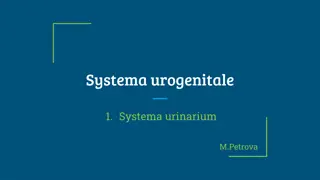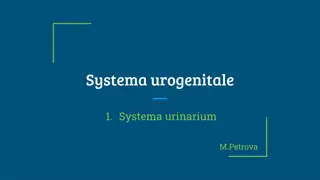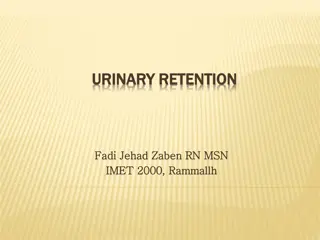Overview of the Urinary System: Functions, Structure, and Importance
The urinary system plays a crucial role in maintaining water and salt balance, regulating pH levels, and excreting waste products like urea and uric acid. Comprising of organs such as the kidneys, ureters, urinary bladder, and urethra, this system ensures the removal of metabolic waste from the body while filtering and purifying blood. The kidneys, located retroperitoneally and surrounded by renal capsule and perirenal fat, are key organs responsible for filtering waste and producing urine. Understanding the functions and structure of the urinary system is essential for overall health and wellness.
Download Presentation

Please find below an Image/Link to download the presentation.
The content on the website is provided AS IS for your information and personal use only. It may not be sold, licensed, or shared on other websites without obtaining consent from the author.If you encounter any issues during the download, it is possible that the publisher has removed the file from their server.
You are allowed to download the files provided on this website for personal or commercial use, subject to the condition that they are used lawfully. All files are the property of their respective owners.
The content on the website is provided AS IS for your information and personal use only. It may not be sold, licensed, or shared on other websites without obtaining consent from the author.
E N D
Presentation Transcript
I. Functions of the Urinary System A. Maintain Water Balance B. Maintain Salt Balance C. Maintain pH [H+] D. Excretion of metabolic (biochemical) waste products = urea (breakdown product of proteins) and uric acid
Urea major waste product in the body Uric acid gouty arthritis or gout - formed from the breakdown of nucleic acids feces = food residues
Regions of the Urinary System A. Kidneys B. Ureters C. Urinary Bladder D. Urethral Canal (urethra)
Purified blood leaves the kidney through the renal vein
Renal vein = lower in waste products, lower in oxygen Renal artery = higher oxygen Most organs in the body are pink because of the number of blood vessels and present in the vessels are red blood cells other organs that are not pink and most other cells/tissues are transparent or has no color
The Kidneys A. reddish-brown organs located retroperitoneally (the reddish color is due to the vascularity of the kidneys) B. the kidneys extend from about T-12 to L-3, with the right kidney located slightly lower than the left kidney
C. the kidneys are surrounded by renal capsule and perirenal fat the fat is for protecting the kidney D. renal cortex Note: interlobar arteries and veins extend through the renal columns of the cortex dividing the kidneys into lobes
E. Renal Medulla (Medullary Pyramids) Note: the urine collecting ducts pass downward through the renal medulla (pyramids) and open into the calyces of the ureter
Urinary System Kidneys produce urine Ureters transport urine to bladder Urinary bladder - stores urine Urethra transports urine to exterior Figure 26.1
Location and External Anatomy of Kidneys Located retroperitoneally Lateral to T12 L3 vertebrae Average kidney 12 cm tall, 6 cm wide, 3 cm thick Hilus On concave (curving in or hollowed) surface Vessels and nerves enter and exit Renal capsule surrounds the kidney
Urinary System in Gross Dissection Figure 26.3
Internal Gross Anatomy of the Kidneys Frontal section through the kidney Renal cortex Renal pyramids Renal pelvis Major calicies Minor calicies Gross vasculature Renal arteries Branch into segmental arteries
Anatomy of the kidneys Superficial outer cortex and inner medulla The medulla consists of 6-18 renal pyramids The cortex is composed of roughly 1.25 million nephrons Major and minor calyces along with the pelvis drain urine to the ureters
Nephron The Functional Unit of Kidney Nephron consists of: Renal corpuscle Renal tubule: Proximal convoluted tubule (PCT) Loop of Henle Distal convoluted tubule (DCT) Nephron empties tubular fluid into a system of collecting ducts and papillary ducts
Consists of: Glomerulus tuft of fenestrated (perforations or apertures) capillaries Glomerular (Bowman s) capsule Parietal layer simple squamous epithelium Visceral layer consists of podocytes (cells in the Bowman s capsule) Blood travels from efferent arteriole to peritubular capillaries Blood leaves the nephron via the efferent arteriole Renal Corpuscle
Blood supply to the kidney Blood flow to the kidney involves a portal system Renal Artery Interlobar Artery Arcuate Artery Interlobar Artery Afferent Glomerular Arteriole Glomerular Capillaries or Capillary Bed (Glomerulus) Efferent Glomerular Arteriole (Portal Vessel) Peritubular Capillaries (Capillary Bed) & Vasa Recta Interlobar Vein Arcuate Vein
Most locations in the body are: Arteries Capillary Bed Vein But there are 3 places in our body wherein we have what we call portal systems What are portal systems? Portal system 2 capillary beds in between Artery Capillary Bed Portal Vessel Capillary Bed Vein
Where can you find portal systems? 1. Hepatic Portal System 2. Kidney 3. Hypothalamic-Pituitary System Example in the liver: Arteries Capillaries Hepatic Portal Vein Liver Or Digestive Tract Arteries Capillaries Hepatic Portal Vein Capillaries Vein
Glomerular Capsule or Bowmans Capsule named after Dr. Bowman
Microanatomy of the Kidney A. The Nephrons (Renal Tubules) cuboidal epithelial cells with microvilli 1. Glomerular (Bowman s) Capsule a. encloses the glomerular capillaries 1. glomerular filtration of blood some of the fluid in the bloodstream filters out into the glomerular capsule
2. Proximal Convoluted Tubule location for tubular reabsorption - the good stuff (sugars & amino acids) is reabsorbed back into the bloodstream (going from the proximal convoluted tubule into the peritubular capillaries)
Loop of Henle (Nephron Loop) - located in the renal medulla - consists of a descending portion and an ascending portion (limb) Distal Convoluted Tubule location for tubular secretion certain specific chemicals are transported out of the peritubular capillaries into the distal convoluted tubule like excess H+, excess NaCl, pencillin antibiotics
The Urine Collecting Ducts (Papillary Ducts) the nephrons empty into the urine collecting ducts, which conduct the urine down to the renal calyces of the ureter The Ureters are a 10-inch long muscular tube that conduct urine from the kidneys to the urinary bladder by peristalsis
Study without thought is labor lost; thought without study is perilous. By nature men are nearly alike, but through experience they grow wide apart. Those who are born wise are the highest type of men; those who become wise through learning come next; those who are dull-witted and yet strive to learn come after that. Those who are dull-witted and yet make no effort to learn are the lowest type of men Confucius























